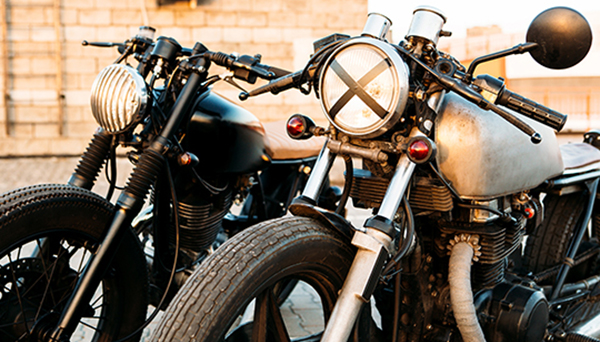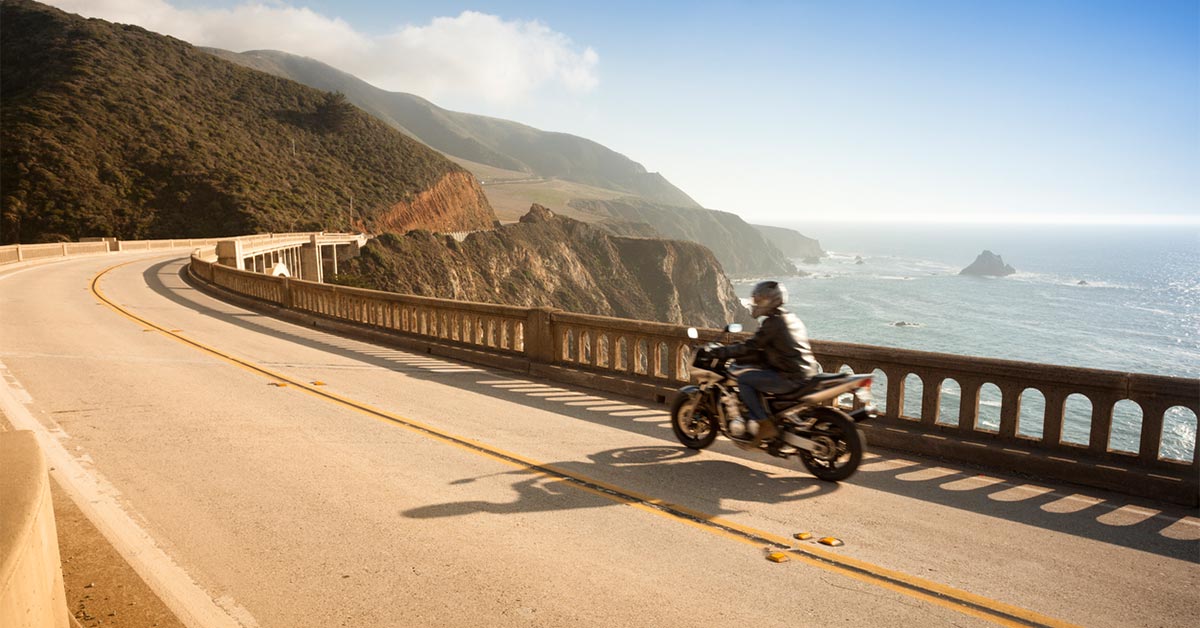Whether you’re looking to buy your first motorcycle or add to your collection, it’s usually more affordable to buy a used one versus a new one. Used motorcycles will range far and wide when it comes to model, condition and price. It can be overwhelming trying to figure out which used motorcycle is right for you, as well as which one is in good enough condition to invest in.
First and foremost, you should research the type of used motorcycle you’re planning on buying. Each brand and type of bike varies in the way it runs and what parts it’s made of. Before going to the seller, make sure you’re prepared to properly test all the parts on the motorcycle. Know exactly what questions to ask before going through with the deal.
To make it easier, we’ve put together a checklist so you can tell the difference between a great buy and a piece of junk.
Used Motorcycle Checklist
1. VIN Number
Checking the VIN number should always be your first step before purchasing a used motorcycle. Check the numbers yourself to make sure they aren’t re-stamped. A legitimate VIN number should ensure that the bike wasn’t stolen. This can be common for bikes with a high-theft rate, like Harley-Davidsons. It also doesn’t hurt to do a background check on the bike to make sure it’s never been stolen in the past.
2. Cold Examination
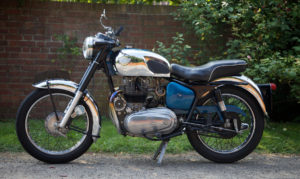 One of the most useful things to do is to examine the motorcycle when its cold, or with the engine off. Tell the seller not to crank the engine before you take a look at it. A hot engine is easy to start and can hide tuning issues. If the seller can’t easily get the bike started right there in front of you, then it probably already has problems.
One of the most useful things to do is to examine the motorcycle when its cold, or with the engine off. Tell the seller not to crank the engine before you take a look at it. A hot engine is easy to start and can hide tuning issues. If the seller can’t easily get the bike started right there in front of you, then it probably already has problems.
3. Engine
The engine is the most expensive part of a motorcycle, so you want to make sure it’s in good condition. After your cold examination, get that bike running. Hear how it starts and go for a test ride to make sure the engine gets up to full operating temperature and has properly functioning electrical components. A test drive is also a good time to check the suspension for any squeaking or grinding noises. If the seller won’t let you ride the bike or run it up and down the block, there might be something suspicious going on.
4. Frame
A used motorcycle should not have any signs of frame damage. If there are any indications of impacts, cracks or repairs, then do not buy the bike. Make sure that the subframe isn’t twisted and that the saddle sits correctly on the frame rails. Also, check around the headstock and weld points for any signs of stress or bends.
5. Body Work
By now you should have already had a pretty good look at the motorcycle, but there are still a few more things you should look out for. Check that the fuel tank is in good general condition, that the fenders and side covers don’t have scratches, dents or broken side-cover tabs, that there are no tears or collapsed foam in the seat and that the windshield is properly mounted without any cracks. It’s also important not be fooled by shiny fairings, plastics or designs on the outside of the bike. Those are cheap to install and can easily hide problems underneath.
6. Handlebar Ends and Levers
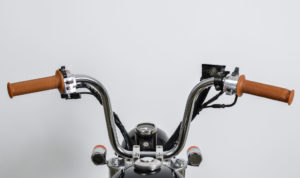 If the handlebars or levers are damaged, it’s a good indication that the motorcycle has suffered a crash. Levers often curl when they hit the pavement, which is a sure sign of a tip-over. If the seller admits to the accident, they might be more trustworthy and let you know if any other parts of the bike were damaged or needed to be fixed. If it goes unmentioned, the seller could also be hiding other issues. They could even be unaware of an accident the previous owner was in.
If the handlebars or levers are damaged, it’s a good indication that the motorcycle has suffered a crash. Levers often curl when they hit the pavement, which is a sure sign of a tip-over. If the seller admits to the accident, they might be more trustworthy and let you know if any other parts of the bike were damaged or needed to be fixed. If it goes unmentioned, the seller could also be hiding other issues. They could even be unaware of an accident the previous owner was in.
7. Cables and Wiring
Pop the seat for a look at all wires and cables. They should be in good condition and do exactly what they’re supposed to do. Electrical wires should look original, untampered with and unexposed. Clutches should be smooth, throttles should snap back as the manufacturer intended and any other cables should be functional. Electrical tape, vampire connectors or a bunch of one-color wire are all red flags that there’s been tampering. Also, beware that if the seller says the decompressor cable is stiff that it could actually mean there’s an issue with the decompressor itself.
8. Wheel Bearings
Definitely make sure to check the bearings on any bike you’re planning on buying. You can grab the wheels and try rocking them sideways on the spindle. If they move around, that’s not a good sign. This can indicate that the seller didn’t take very good care of the motorcycle.
9. Wheels and Tires
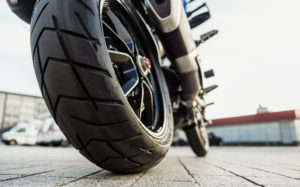 Some of the easiest parts to check are the wheels and tires. They should both be in condition and free from dings or dents. Tires with flat areas indicate burnouts. Little blobs of rubber or tiny surface ripples on the tires indicate the bike was ridden on the track. Both mean that the tires are worn from heavy usage. If the tires need to be replaced before you can ride, consider factoring that cost into your offer.
Some of the easiest parts to check are the wheels and tires. They should both be in condition and free from dings or dents. Tires with flat areas indicate burnouts. Little blobs of rubber or tiny surface ripples on the tires indicate the bike was ridden on the track. Both mean that the tires are worn from heavy usage. If the tires need to be replaced before you can ride, consider factoring that cost into your offer.
10. Brakes
One of the most important parts of a motorcycle are the brakes. Make sure that all the discs are the correct width, unwarped and don’t have any scoring. Check that the brake fluids are light in color, not brown or murky. Brake pads should be intact with plenty of material left on them.
11. Drive Train
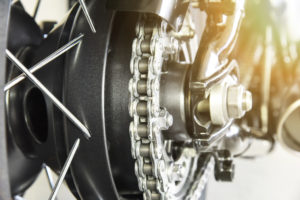 The more a motorcycle is used, the more worn the chain and sprockets become. Depending on how old the bike is, you shouldn’t be too concerned about some wear on the chain, as long as it doesn’t seem like anything needs to be replaced right away. Wear is inevitable, and when the chain and sprockets do need to be changed, it’s a cheap and easy fix. However, a rusty chain can indicate that more parts are rusted under the outer plastics, probably making the bike a bad investment.
The more a motorcycle is used, the more worn the chain and sprockets become. Depending on how old the bike is, you shouldn’t be too concerned about some wear on the chain, as long as it doesn’t seem like anything needs to be replaced right away. Wear is inevitable, and when the chain and sprockets do need to be changed, it’s a cheap and easy fix. However, a rusty chain can indicate that more parts are rusted under the outer plastics, probably making the bike a bad investment.
Always Research The Used Motorcycle First
As you can see, it’s important to know about all the parts and components of the brand and model motorcycle you’re planning on buying before meeting with the seller to check out the bike. Asking the right questions and knowing exactly what to look for is the only way to ensure you’re making a good investment. Avoid any used motorcycles with hectic electrical wires, leaks of any kind, spongy breaks or rusty fuel tanks. Unless you want a fixer-upper, these issues can be expensive.
Overall, you should pay attention to the general condition of the bike. Does it have matching tires, shiny paint and newer grips and seat covers? Motorcycle owners tend to either love or neglect their bikes. If you can tell the seller has taken care of the bike, then it’s probably in pretty good condition. On the other hand, if there are parts that haven’t been repaired or replaced for a while, it’s likely there could be other issues lurking.
Other Tips
- Trust your gut. If anything about the seller or the transaction feels wrong or off, then something probably is. Don’t let the seller try to confuse you. Stick to what you know to be true about the motorcycle you’re looking at. If you’re not comfortable handing over that wad of cash, definitely don’t do it and move on.
- If you’re a woman rider. Brands like Honda, Yamaha and Harley-Davidson have been adapting their motorcycles to fit the needs of women riders. Buying a bike from a fellow woman rider could be beneficial in the way you ride. Look for sellers that are also women, so you can get a used bike that fits your needs!
- Consider resale value. Buying a used motorcycle is an investment and you may want to sell it for an upgrade in the future. Consider how old and worn the bike is before purchasing. Is the bike so old that you’re going to be running it in to the ground or is there potential for upkeep and resale within the next couple years?
Motorcycle Insurance
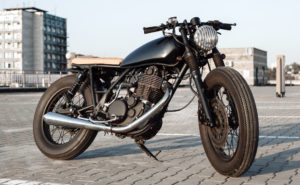 Whether this is your first used motorcycle or you’re simply adding to your collection, make sure you have adequate Motorcycle Insurance. Motorcycle insurance rates are usually less expensive than Car Insurance rates, and you want to be covered in case of an accident. Call an Insurance Specialist at 888.772.4247 to compare several Motorcycle Insurance quotes for your new, used motorcycle.
Whether this is your first used motorcycle or you’re simply adding to your collection, make sure you have adequate Motorcycle Insurance. Motorcycle insurance rates are usually less expensive than Car Insurance rates, and you want to be covered in case of an accident. Call an Insurance Specialist at 888.772.4247 to compare several Motorcycle Insurance quotes for your new, used motorcycle.
The information in this article is obtained from various sources. This content is offered for educational purposes only and does not represent contractual agreements. The definitions, terms and coverages in a given policy may be different than those suggested here. No warranty or appropriateness for a specific purpose is expressed or implied.
